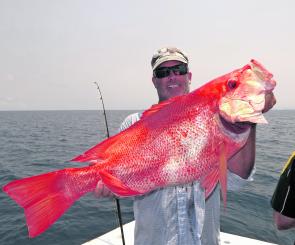We are now in the heart of the dry season in the tropics and are experiencing a typical winter pattern. The offshore fishing is firing along nicely and even though the inshore scene is a bit more challenging there have been some good results all the same.
In our rivers and creeks the winter species are dominating the catches at the moment along with common species such as thumper-sized bream, golden trevally, small GT, queenfish, sickle fish and some healthy blue salmon.
The neapish tides are fishing the best with a slow run-in tide during the day with the water clarity at its optimum. During the cooler phases of the year water clarity is paramount and conditions that see wind and water movement going in the same direction give you the best chance. Generally speaking this means an incoming tide with an associated southeasterly breeze working together. Big tides, especially on the out going, can clash with the wind and what you get is a very volatile system and very stirred up conditions with terrible water clarity.
If you have water colour with a nice clear tinge to it, lure casting and live baiting can be very successful. If you are forced to work with dirty water, fresh dead baits are extremely effective and an old fashioned beauty is a bit of pilchard and squid combined. It gives the fish something to sniff out when the visibility is low. You’ll be surprised at the amount of fish that will accept such a bait during the cooler months. Also keep in mind that the bright sunny days seem to assist the fishing greatly while those dark gloomy days can be an absolute challenge.
A very worthwhile exercise during the winter months is to target the gutters and yabby beds along our beaches. Just armed with a light spinning reel you can use small prawn baits or flick a small soft plastic and come up with all sorts of goodies.
It pays to study the landscape on those very low tides and work out where these fish are likely to hold. You’ll see where the yabbies have been gathering and where fish have been digging up the sand searching for food, and quite often there will be hide marks where flathead having been lying in wait for an ambush. These are the spots to return to on an incoming tide and could encounter a variety of species including trevally, dart, whiting, permit, flathead and queenfish.
The key ingredient to success is calm conditions and a clean incoming tide. You may not catch monster fish but you can catch a variety in good numbers. On light gear these fish will give as good a fight as any other.
Offshore fishing is awesome at this time of year but it has been difficult to even get out there at times due to some very persistent strong southeasterly breezes. Some of these blocks have seen the winds rip up the coast for 10 days at a time making it impossible to reach the outer reef. However there have been stretches where the weather has been kind and the fishing has been great.
Winter on the reef is a prime time as the fish relish a drop in the water temperature. By far the best results have come from fishing in the deeper water on isolated bommies and rubble patches. Deep water can mean anywhere between 35-60m of water and these are the preferred depths for the schools of large mouth nannygai. They are biting very well during the day and as it often happens there are a variety of other quality species roaming with these schools as well.
Trevally are often encountered with nannygai and if they are of the golden variety all the better. Another prized species which has been turning up with regularity along with the large mouth in the deeper waters have been the red emperor, and quite a few have been the super-sized models up to 10-12kg.
More often in these open waters where there is a concentration of bait and bigger fish, the Spanish mackerel will also be within striking range and it is mandatory to have a floating rig with a pilchard or, even better, a live fusilier on offer. When the bite is on there will be activity right through the water column and it can become hectic work on the deck. It’s also worth mentioning that these floating rigs have also come under the scrutiny of reef mangrove jack and cobia, which are trophy species themselves.
It’s not all about just fishing deep on the reef because our shallower bommies in 15-30m of water have been ripe for coral trout and a host of other species including sweetlip, Moses perch and stripeys. Also schools of spangled emperor can wander by and partake in the action and this can be an exciting prospect as they hunt in solid numbers.
At the moment there is all round quality fishing to be had on the Great Barrier Reef and if you can manage a day with clear skies and a gentle breeze, it really is a great tropical experience.
Reads: 3073
There’s been a huge focus on these beauties – quality large mouth nannygai.




